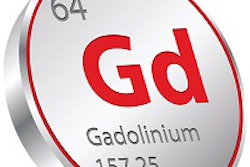
Amid persistent concerns over the safety of gadolinium MRI contrast agents, a new study published in the April issue of the American Journal of Roentgenology reinforces the "relatively robust safety profile" of at least one MRI agent. Adverse reactions were tracked over nearly eight years and found to be "infinitesimally small."
Researchers from the University of Pittsburgh Medical Center (UPMC) tracked adverse events related to gadobenate dimeglumine over a 7.5-year period in which it was in use at their facility. They found an adverse and allergic reaction rate of 0.18%, with only slightly more half of the reported incidents requiring treatment and a handful of cases considered serious.
"The risk is so infinitesimally small compared to most drugs that you take every day without thinking twice about it," lead author Dr. Saeed Fakhran, UPMC assistant professor of radiology, told AuntMinnie.com. "For the amount of time that we use [contrast-enhanced MRI], it is amongst the safest things we do in medicine."
Contrast of choice
The U.S. Food and Drug Administration (FDA) in November 2004 cleared gadobenate dimeglumine, which is marketed by Bracco Diagnostics as MultiHance. UPMC began using MultiHance as its preferred gadolinium-based contrast agent for MRI in the second quarter of 2005.
 Dr. Saeed Fakhran, assistant professor of radiology, University of Pittsburgh Medical Center.
Dr. Saeed Fakhran, assistant professor of radiology, University of Pittsburgh Medical Center.The authors recalled in their paper that at the time there was "intense interest and a degree of anxiety regarding its safety profile." So the institution embarked on a 13-month study to evaluate the contrast agent. The research found no significant increase in adverse events compared with other previously published studies about other MRI contrast agents (AJR, February 2011, Vol. 196:2, pp. W138-W143).
Still, some skepticism remained, due in part to reported incidents of patients contracting the debilitating condition known as nephrogenic systemic fibrosis (NSF) after a MRI scan using gadolinium-based agents. Ultimately, it was found that the risk of NSF was much higher in patients with insufficient renal function; the number of NSF cases began plummeting once the use of gadolinium contrast was restricted in these individuals.
"There have been lots of studies evaluating contrast safety, but there are still questions out there," Fakhran said. "You can do all the studies you want, but there is always the anecdotal story that everyone has heard from this one patient one time that always trumps everything."
Fakhran and colleagues conceded that previous research into the safety of gadolinium-based contrast agents have had limitations, such as relatively small sample sizes or a focus on a narrow patient population.
"To our knowledge ... no large-scale single-center prospective evaluations of the safety profile of gadobenate dimeglumine have been undertaken," they wrote. "We sought to expand our initial study beyond its initial 13-month time frame to better assess the everyday reality of clinically experienced adverse reactions to gadobenate dimeglumine at our institution over 7.5 years."
Everyone's welcome
This study's cohort included a total of 132,252 patients who were given gadobenate dimeglumine (52% of all MRI exams) at UPMC's primary tertiary care facility and its community hospital between April 2005 and March 2013 (AJR, April 2015, Vol. 204:4, pp. 703-707).
All patients were prospectively evaluated for symptoms before and immediately after their contrast-enhanced MRI scans and again before discharge. The average time for observation after contrast administration across the facilities was 30 minutes.
When researchers reviewed the scans, they tallied 236 patients with reactions, leading to an adverse event rate of 0.18%. They found 56 patients (0.04%) who reported multiple adverse reactions.
| Frequency of reactions to gadobenate dimeglumine | |
| Reaction | Frequency |
| Hives | 62% |
| Dyspnea | 15% |
| Nausea | 11% |
| Vomiting | 7% |
| Chest pain | 6% |
| Tingling | 5% |
| Gagging | 3% |
| Other | 3% |
Of the 236 patients with an adverse event, 133 people (56%) required some form of intervention or treatment, and 12 patients (less than 0.01% of the total cohort) had reactions that were considered serious.
Interestingly, the adverse reaction rate was greater at UPMC's main hospital (0.23%) compared with its community facility (0.07%), a result that puzzled the researchers.
"We saw this difference, and we all kind of scratched our heads," Fakhran said. "We guess maybe that the patients [at the tertiary facility] are sicker and that has something to do with it."
Caregiver apprehension?
In addition, the study found that adverse reaction rates were greater in the first two years of gadobenate dimeglumine use. The reaction rate was 0.38% in the first year and 0.41% in the second year. The trend eventually decreased to an average baseline rate of 0.16% over the next 5.5 years.
The trend is "consistent" with the so-called Weber and Lalli effects, Fakhran and colleagues wrote. These effects theorize that the greatest number of adverse drug events will occur after their introduction, and a caregiver's apprehension about the safety of a drug can be subliminally transferred to a patient.
"This pattern that we saw with gadobenate dimeglumine is a very common one across the pharmacological spectrum," Fakhran explained. "Some of that has to do with the novelty of the drug and the person giving it not being used to [administering] it. Over time, that [high rate] plateaus."
As for the other part of the Weber and Lalli effects, researchers speculated that if the person giving a contrast agent believes it is "benign and beneficial, this attitude will be communicated to the patient without those words being said," they wrote. "In a similar manner, if the person administering an agent believes there is a high likelihood that an adverse event will occur, that, too, will be effectively communicated to the patient."
"We believe that the psychologic effect of these opinions and beliefs contributes to the expectations of the patient about the contrast administration and can thereby either increase or decrease the likelihood of an adverse reaction," they concluded.
The authors cited several limitations of their study, including the omission of information regarding delayed adverse reactions of patients after discharge.
"The big limitation of this paper is that we did not evaluate NSF," Fakhran added. "We are now doing a study looking at NSF and its risk factors. How can we better stratify people? Does cutting the amount of contrast help? That is the next big area that we will move on to, and it is a popular area and MR safety."
At least for now, the bottom line is that MRI is "safe with or without contrast," Fakhran said. "People should go in with a calm confidence, knowing that this is a safe test. The contrast you are given is safe and this test will help you far more than any potential harm it may do."
Study disclosures
Study co-author Dr. Emanuel Kanal is a consultant for Bayer HealthCare and Guerbet and receives grant support from Bracco.




















